
Fort Augustus is a settlement in the parish of Boleskine and Abertarff, at the south-west end of Loch Ness, Scottish Highlands. The village has a population of around 646 (2001). Its economy is heavily reliant on tourism.

The Stirling council area is one of the 32 council areas of Scotland, and has a population of about 94,330. It was created under the Local Government etc (Scotland) Act 1994 with the boundaries of the Stirling district of the former Central local government region, and it covers most of Stirlingshire and the south-western portion of Perthshire. Both counties were abolished for local government purposes under the Local Government (Scotland) Act 1973.

The Battle of Preston was the final action of the Jacobite rising of 1715, an attempt to put James Francis Edward Stuart on the British throne in place of George I.

Sheriffmuir, the site of the inconclusive 1715 Battle of Sheriffmuir, lies on the slopes of the Ochil Hills in Scotland, just inside the Perthshire border. The "Sheriffmuir Inn", which overlooks the battle site, used to house Hercules the wrestling bear for which it is well known.
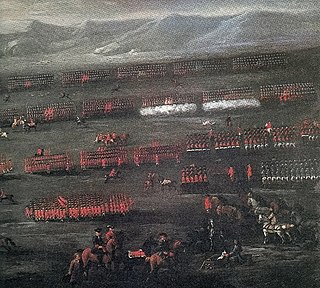
The Battle of Sheriffmuir was an engagement in 1715 at the height of the Jacobite rising in England and Scotland. The battlefield has been included in the Inventory of Historic Battlefields in Scotland and protected by Historic Scotland under the Scottish Historical Environment Policy of 2009. Sheriffmuir was and is a remote elevated plateau of heathland lying between Stirling and Auchterarder on the north fringe of the Ochil Hills.

Castle Tioram is a ruined castle that sits on the tidal island Eilean Tioram in Loch Moidart, Lochaber, Highland, Scotland. It is located west of Acharacle, approximately 80 km (50 mi) from Fort William. Though hidden from the sea, the castle controls access to Loch Shiel. It is also known to the locals as "Dorlin Castle". The castle is a scheduled monument.

The Silver Glen lies approximately 1 kilometre (0.62 mi) to the east of the town of Alva, Clackmannanshire, Scotland, and takes its name from the silver that was mined there in the early 18th century. The deposit, the richest deposit of native silver ever found in the British Isles, was discovered just as the Jacobite rising of 1715 was breaking out, and its owner, Sir John Erskine, left to join the rebels, leaving his wife in charge of the mine. Some 40 tons of ore were raised and buried in barrels in the grounds of Alva House at the foot of the Ochil Hills, about 10 kilometers east of Stirling, whilst the richest of the ore was smelted and the ingots concealed under floorboards inside the house. The mine was then filled in during the aftermath of the failed rising, but its existence was revealed to the government by an employee of the Erskines. Samples of the ore were analysed by Sir Isaac Newton and found to be very rich. Sir John was later able to secure a pardon for his role in the rising, on condition he revealed all he knew about the mine, and gave a tenth of the proceeds to the government. Mining resumed a few years later and the remainder of the deposit was extracted. Later, in 1759, a vein carrying erythrite, an ore of cobalt, was found and gave a new lease of life to the mines, but it was soon exhausted.
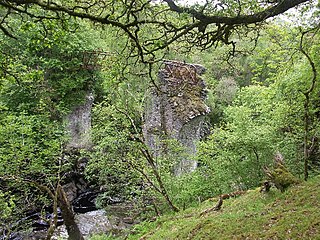
The Highbridge Skirmish was the first engagement of the Jacobite Rising of 1745 between government troops and Jacobites loyal to Prince Charles Edward Stuart. It took place at Highbridge, Lochaber, on the River Spean on 16 August 1745, and marked the commencement of hostilities between the two sides.
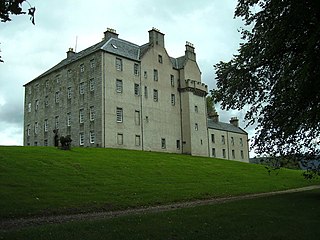
Castle Grant stands a mile north of Grantown-on-Spey and was the former seat of the Clan Grant chiefs of Strathspey in Highlands, Scotland. It was originally named Freuchie Castle but was renamed Grant in 1694. The castle is a Category A listed building and the grounds are included in the Inventory of Gardens and Designed Landscapes in Scotland.

Kinbuck is a hamlet in Stirlingshire, Scotland. It lies by the Allan Water and the Stirling-Perth Railway line. It is four miles north of Dunblane.

The Jacobite rising of 1715 was the attempt by James Edward Stuart to regain the thrones of England, Ireland and Scotland for the exiled Stuarts.

Skerton Bridge is a road bridge carrying the southbound lanes of the A6 road over the River Lune in Lancaster, Lancashire, England. The bridge is recorded in the National Heritage List for England as a designated Grade II* listed building and Scheduled Monument.

The Caledonian Railway Bridge is a bridge crossing the River Clyde at Broomielaw in Scotland. It is adjacent to Glasgow Central station.

Tullibardine is a location in Perth and Kinross, Scotland, which gives its name to a village, a castle, and a grant of nobility.

Kinnaird Castle is a 15th-century castle near Brechin in Angus, Scotland. The castle has been home to the Carnegie family, the Earls of Southesk, for more than 600 years. It is a Category B listed building and the grounds are included in Inventory of Gardens and Designed Landscapes in Scotland.
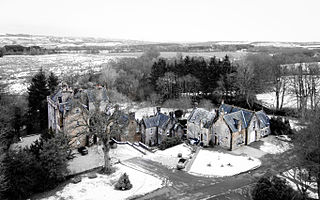
Bridge Castle is an L-plan castle, dating from the 16th century, standing on a rocky site 3 miles (4.8 km) north west of Bathgate in West Lothian, Scotland, on the west of the Barbauchlaw Burn. The former name of the castle was Little Brighouse.
German submarine U-739 was a Type VIIC U-boat built for Nazi Germany's Kriegsmarine for service during World War II. She was laid down on 17 April 1942 by Schichau-Werke, Danzig as yard number 1536, launched on 23 December 1942 and commissioned on 6 March 1943 under Leutnant zur See Ernst Mangold.
Events from the year 1752 in Scotland.
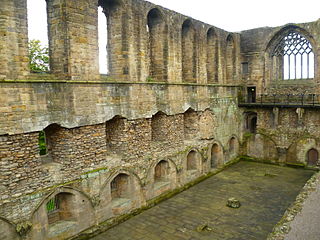
The Skirmish of Dunfermline was a conflict that took place on 24 October 1715 in Dunfermline, Scotland and was part of the Jacobite rising of 1715. It was fought between the forces of John Campbell, 2nd Duke of Argyll who supported the British-Hanoverian Government against a Jacobite force.
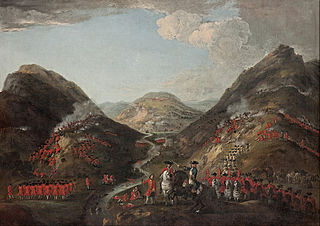
Joseph Wightman was a British military officer of the early eighteenth century. He is best remembered for his part in the suppression of the 1715 and 1719 Jacobite rebellions.


















